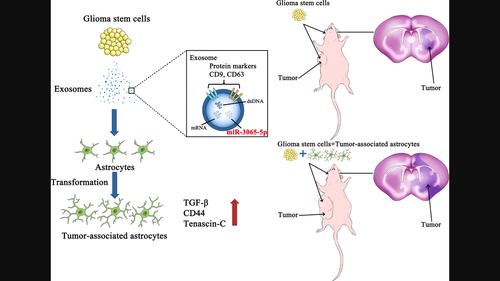Our official English website, www.x-mol.net, welcomes your feedback! (Note: you will need to create a separate account there.)
Glioma stem cell-derived exosomes induce the transformation of astrocytes via the miR-3065-5p/DLG2 signaling axis
Glia ( IF 6.2 ) Pub Date : 2024-01-17 , DOI: 10.1002/glia.24506 Haoran Li 1, 2 , Jianjun Zhu 2 , Xinglei Liu 1 , Liang Liu 3 , Shilu Huang 1 , Anyi Wu 1 , Zhipeng Xu 1 , Xiaopei Zhang 1 , Zengyang Li 1 , Fan Ni 1 , Lijun Liu 2 , Jun Dong 1
Glia ( IF 6.2 ) Pub Date : 2024-01-17 , DOI: 10.1002/glia.24506 Haoran Li 1, 2 , Jianjun Zhu 2 , Xinglei Liu 1 , Liang Liu 3 , Shilu Huang 1 , Anyi Wu 1 , Zhipeng Xu 1 , Xiaopei Zhang 1 , Zengyang Li 1 , Fan Ni 1 , Lijun Liu 2 , Jun Dong 1
Affiliation

|
Tumor-associated astrocytes (TAAs) in the glioblastoma microenvironment play an important role in tumor development and malignant progression initiated by glioma stem cells (GSCs). In the current study, normal human astrocytes (NHAs) were cultured and continuously treated with GSC-derived exosomes (GSC-EXOs) induction to explore the mechanism by which GSCs affect astrocyte remodeling. This study revealed that GSC-EXOs can induce the transformation of NHAs into TAAs, with relatively swollen cell bodies and multiple extended processes. In addition, high proliferation, elevated resistance to temozolomide (TMZ), and increased expression of TAA-related markers (TGF-β, CD44, and tenascin-C) were observed in the TAAs. Furthermore, GSC-derived exosomal miR-3065-5p could be delivered to NHAs, and miR-3065-5p levels increased significantly in TAAs, as verified by miRNA expression profile sequencing and Reverse transcription polymerase chain reaction. Overexpression of miR-3065-5p also enhanced NHA proliferation, elevated resistance to TMZ, and increased the expression levels of TAA-related markers. In addition, both GSC-EXO-induced and miR-3065-5p-overexpressing NHAs promoted tumorigenesis of GSCs in vivo. Discs Large Homolog 2 (DLG2, downregulated in glioblastoma) is a direct downstream target of miR-3065-5p in TAAs, and DLG2 overexpression could partially reverse the transformation of NHAs into TAAs. Collectively, these data demonstrate that GSC-EXOs induce the transformation of NHAs into TAAs via the miR-3065-5p/DLG2 signaling axis and that TAAs can further promote the tumorigenesis of GSCs. Thus, precisely blocking the interactions between astrocytes and GSCs via exosomes may be a novel strategy to inhibit glioblastoma development, but more in-depth mechanistic studies are still needed.
中文翻译:

胶质瘤干细胞来源的外泌体通过 miR-3065-5p/DLG2 信号轴诱导星形胶质细胞转化
胶质母细胞瘤微环境中的肿瘤相关星形胶质细胞(TAAs)在胶质瘤干细胞(GSC)引发的肿瘤发生和恶性进展中发挥着重要作用。在本研究中,培养正常人星形胶质细胞(NHA)并持续用GSC源性外泌体(GSC-EXOs)诱导处理,以探讨GSC影响星形胶质细胞重塑的机制。这项研究表明,GSC-EXOs可以诱导NHA转化为TAA,具有相对肿胀的细胞体和多个延长的过程。此外,在 TAA 中观察到高增殖、对替莫唑胺 (TMZ) 的耐药性升高以及 TAA 相关标记物(TGF-β、CD44 和生腱蛋白-C)表达增加。此外,GSC 衍生的外泌体 miR-3065-5p 可以被递送至 NHA,并且 miR-3065-5p 水平在 TAA 中显着增加,经 miRNA 表达谱测序和逆转录聚合酶链反应验证。miR-3065-5p 的过表达还增强了 NHA 增殖,提高了对 TMZ 的耐药性,并增加了 TAA 相关标志物的表达水平。此外,GSC-EXO 诱导的 NHA 和 miR-3065-5p 过表达的 NHA 均促进体内 GSC 的肿瘤发生。Discs Large Homolog 2(DLG2,在胶质母细胞瘤中下调)是 TAA 中 miR-3065-5p 的直接下游靶标,DLG2 过表达可以部分逆转 NHA 向 TAA 的转化。总的来说,这些数据表明 GSC-EXO 通过 miR-3065-5p/DLG2 信号轴诱导 NHA 转化为 TAA,并且 TAA 可以进一步促进 GSC 的肿瘤发生。因此,通过外泌体精确阻断星形胶质细胞和 GSC 之间的相互作用可能是抑制胶质母细胞瘤发展的新策略,但仍需要更深入的机制研究。
更新日期:2024-01-17
中文翻译:

胶质瘤干细胞来源的外泌体通过 miR-3065-5p/DLG2 信号轴诱导星形胶质细胞转化
胶质母细胞瘤微环境中的肿瘤相关星形胶质细胞(TAAs)在胶质瘤干细胞(GSC)引发的肿瘤发生和恶性进展中发挥着重要作用。在本研究中,培养正常人星形胶质细胞(NHA)并持续用GSC源性外泌体(GSC-EXOs)诱导处理,以探讨GSC影响星形胶质细胞重塑的机制。这项研究表明,GSC-EXOs可以诱导NHA转化为TAA,具有相对肿胀的细胞体和多个延长的过程。此外,在 TAA 中观察到高增殖、对替莫唑胺 (TMZ) 的耐药性升高以及 TAA 相关标记物(TGF-β、CD44 和生腱蛋白-C)表达增加。此外,GSC 衍生的外泌体 miR-3065-5p 可以被递送至 NHA,并且 miR-3065-5p 水平在 TAA 中显着增加,经 miRNA 表达谱测序和逆转录聚合酶链反应验证。miR-3065-5p 的过表达还增强了 NHA 增殖,提高了对 TMZ 的耐药性,并增加了 TAA 相关标志物的表达水平。此外,GSC-EXO 诱导的 NHA 和 miR-3065-5p 过表达的 NHA 均促进体内 GSC 的肿瘤发生。Discs Large Homolog 2(DLG2,在胶质母细胞瘤中下调)是 TAA 中 miR-3065-5p 的直接下游靶标,DLG2 过表达可以部分逆转 NHA 向 TAA 的转化。总的来说,这些数据表明 GSC-EXO 通过 miR-3065-5p/DLG2 信号轴诱导 NHA 转化为 TAA,并且 TAA 可以进一步促进 GSC 的肿瘤发生。因此,通过外泌体精确阻断星形胶质细胞和 GSC 之间的相互作用可能是抑制胶质母细胞瘤发展的新策略,但仍需要更深入的机制研究。



























 京公网安备 11010802027423号
京公网安备 11010802027423号